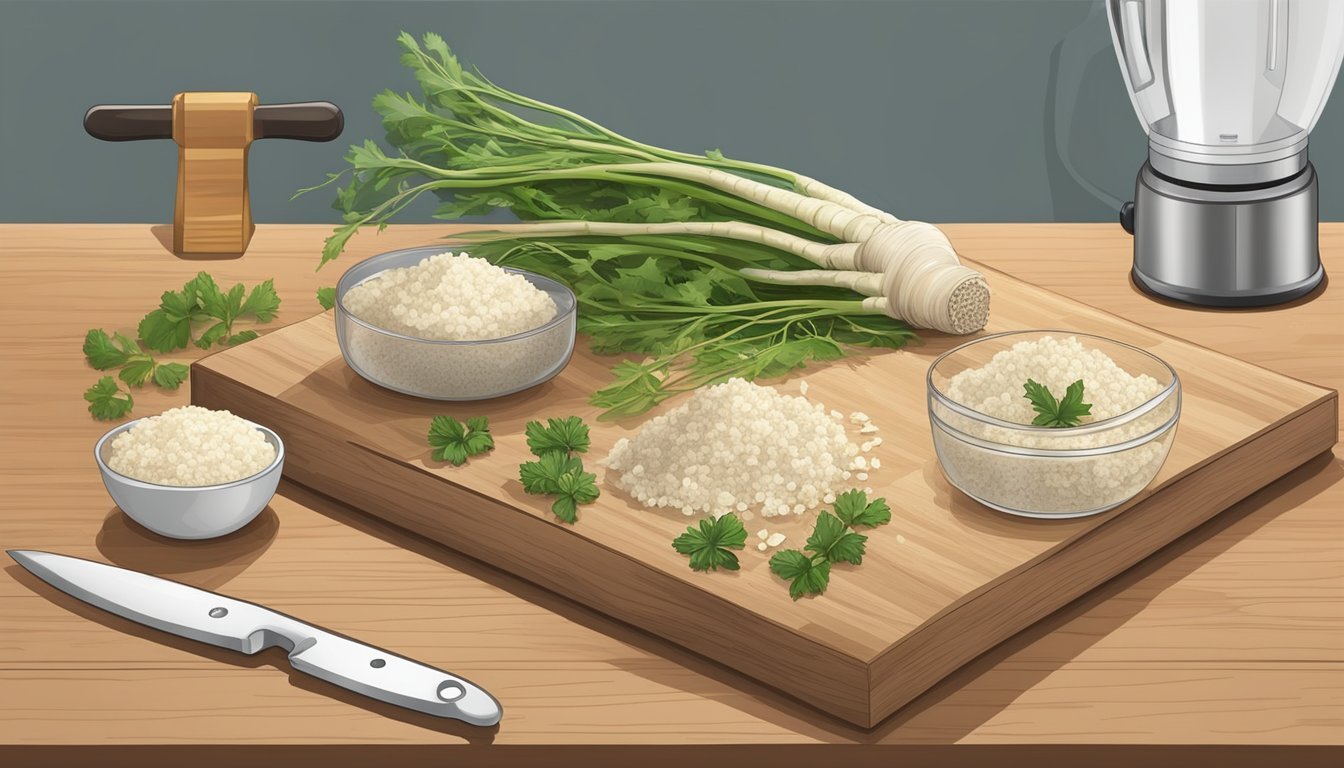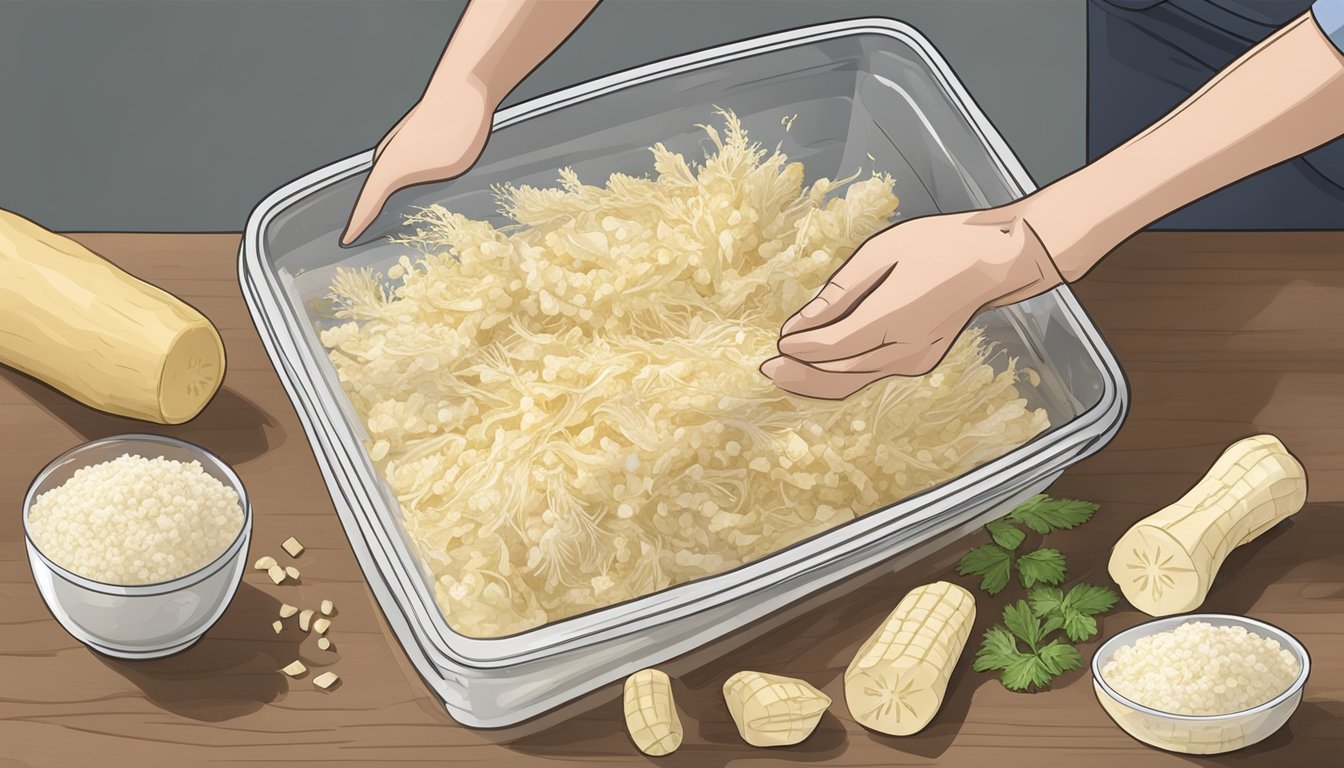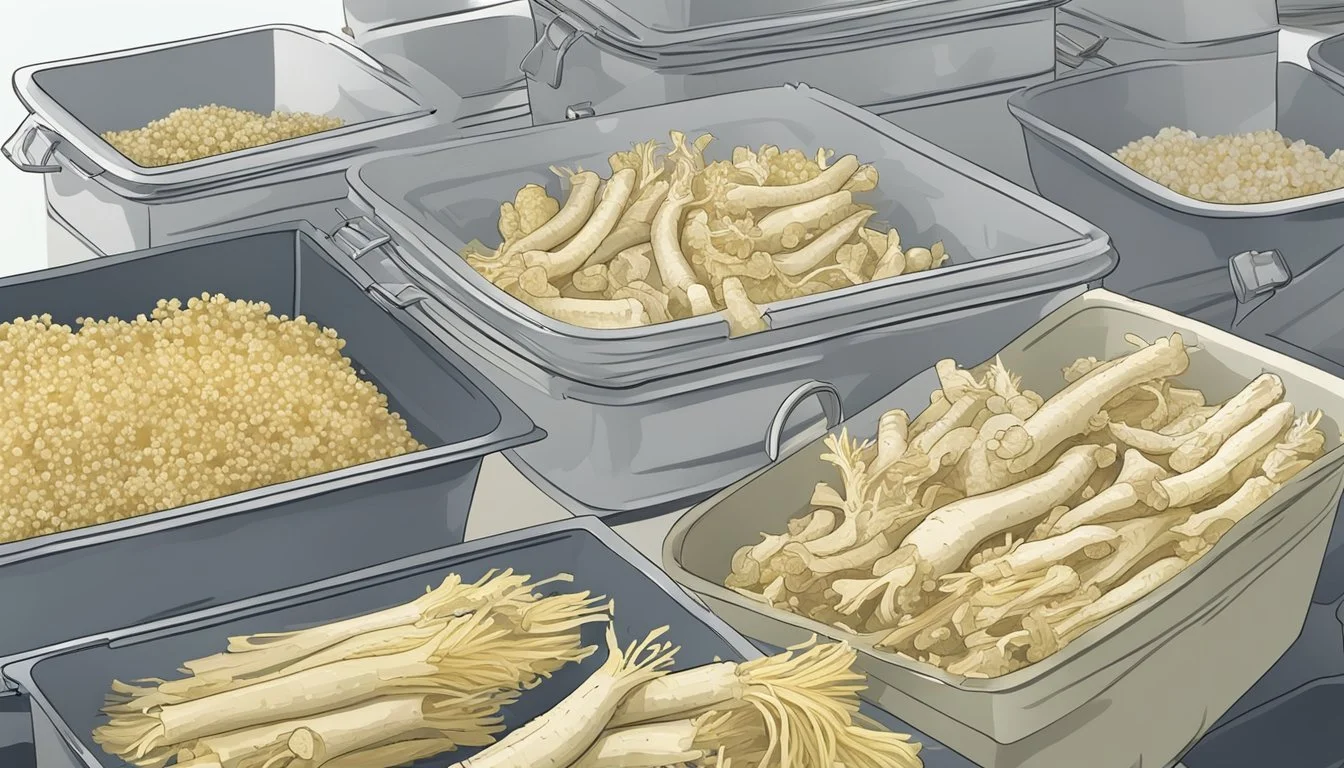How to Freeze Fresh Horseradish for Zesty Sauces
Preserving Spiciness
Horseradish, a perennial plant with a pungent root, is often used as a condiment to add a zesty flavor to various dishes, particularly sauces. As a fresh ingredient, it imparts a potent kick that can transform the taste profile of culinary creations. However, preserving this intensity of flavor for long periods can be a challenge, and freezing presents itself as a practical solution for extending the shelf life of horseradish.
When preparing horseradish for freezing, it is important to handle the root with care to maintain its distinct taste. The process typically involves cleaning, peeling, and grating or chopping the fresh root, which is then mixed with white vinegar and salt before being packed for freezing. Adopting the right technique ensures that the unique properties of the horseradish are retained, making it readily available for future use without compromising on quality.
By storing horseradish in the freezer, chefs and home cooks alike can preserve the vibrant heat and robust flavor that this root is known for. Freezing not only keeps the horseradish fresh for months but also offers the convenience of having this powerful ingredient on hand for spontaneous meal preparations, ensuring that sauces and other dishes can always have that characteristic zesty punch.
Selecting Quality Horseradish Roots
When choosing horseradish, an individual seeks the freshest, highest quality roots for the most potent flavor. They must ensure that the roots are firm and do not have any soft spots, which could indicate decay. The outer skin should be blemish-free, and the appearance overall should be that of a typical healthy root vegetable: robust and free from any signs of withering or dryness.
A high-quality fresh horseradish root will also be relatively heavy for its size, an indicator of a fresh harvest and high moisture content. It is advisable to select roots with a clean cut on their ends, signaling they were recently harvested. The size of the root is not always a guaranteed quality indicator, but larger roots are often woodier, so one might preferably choose medium-sized horseradish for freezing.
Key Points for Selection:
Firmness: The root should feel solid throughout.
Surface: Examining for blemishes or soft spots helps to ensure root health.
Freshness: A fresh cut at the end of the root indicates recent harvesting.
Weight: A heavier root suggests higher moisture content, which is desirable.
By selecting horseradish with these considerations in mind, the consumer guarantees that when they move to preserve the horseradish through freezing, they are starting with the best possible quality. This commitment to initial quality will reflect in the zesty, flavorful sauces created from their carefully chosen roots.
Preparing Horseradish for Freezing
Proper preparation of horseradish for freezing is essential to maintain its potent flavor and texture. This section guides you through cleaning, grating, and packaging horseradish before freezing, along with tips on preservative use and labeling for optimal shelf life.
Cleaning and Peeling
Before freezing horseradish, it must be thoroughly cleaned to remove any dirt and debris. First, wash the roots under cold running water, scrubbing with a brush if necessary. Once clean, peel the skin using a vegetable peeler or a sharp knife, ensuring all the brown outer layer is removed and the white flesh is fully visible.
Grating the Horseradish
Grate the peeled horseradish using a cheese grater or food processor. Aim for a consistent fine or coarse texture, depending on your preference. When using a food processor, pulse to achieve an even consistency without over-processing, which could lead to a mushy texture.
Portioning and Packaging
Portion the grated horseradish into manageable quantities, typically 1 cup portions, to make it easier to use in recipes later. Package these portions into freezer bags, pressing out excess air to avoid freezer burn. Alternatively, wrap the portions in foil before placing them in airtight containers.
Adding Preservatives
To preserve flavor and prevent discoloration, mix the grated horseradish with a preservative. A common preservative solution includes:
2 tablespoons of vinegar or lemon juice
1/2 teaspoon of salt
Stir this mixture into the grated horseradish before packaging.
Airtight Sealing to Prevent Freezer Burn
Ensure packages are airtight to prevent freezer burn, which can spoil the flavor and texture of the horseradish. Press out excess air from freezer bags or ensure containers have secure, airtight lids. A secondary larger freezer bag can be used to contain fumes and offer an additional layer of protection.
Labeling and Date Recording
Label each package with the contents and the freeze date. Accurate labeling is crucial for keeping track of shelf life and to quickly identify the contents when needed. The shelf life of frozen horseradish is around six months to a year, after which it may lose potency.
Freezing Process and Storage
Freezing fresh horseradish ensures the pungent flavor and fiery heat are locked in for later use. This section outlines the necessary steps and precautions to properly freeze horseradish and maximize its shelf life.
Pre-Freeze Precautions
Before freezing, one should wash and peel the fresh horseradish roots to remove dirt and impurities. It is preferable to grate or chop the horseradish finely as this will allow for easier use after thawing and help in preserving its potent flavor.
Correct Freezer Temperature Setting
Maintaining the correct freezer temperature is crucial; set your freezer to 0°F (-18°C) to ensure the horseradish freezes quickly. A rapid freeze helps in preserving the texture and flavor of the horseradish, reducing ice crystal formation which can damage the cell structure.
Maximizing Shelf Life in Freezer
To maximize the shelf life of frozen horseradish:
Portion the prepared horseradish into usable amounts, typically 1 cup portions work well.
Place portions into heavy-duty freezer bags or an airtight container to prevent freezer burn.
Expel as much air as possible from bags before sealing to maintain quality.
Label bags with the date to keep track of how long they have been stored. Following these steps, horseradish can be kept frozen for up to 6 months while maintaining optimal quality.
Reducing Spoilage and Maintaining Quality
To reduce spoilage and maintain quality during storage:
Check the integrity of the freezer bags or containers occasionally for any signs of damage.
Ensure horseradish is stored at the back of the freezer, where the temperature is most consistent.
For grated horseradish, stir in a small amount of vinegar before freezing to help preserve its flavor and prevent discoloration.
By following these guidelines, one can effectively freeze horseradish, retaining its zesty flavor and quality for a considerable period.
Thawing and Using Frozen Horseradish
To retain the spicy flavor of horseradish, proper thawing methods are essential before using it in various culinary creations. Understanding the thawing process and its implications on texture and flavor will ensure horseradish maintains its zest when added to recipes.
Safe Defrosting Methods
For safe defrosting, the most recommended method is to transfer the frozen horseradish to the refrigerator. It should be left to thaw overnight. This gradual process helps to preserve the texture and flavoring capabilities of horseradish. An alternative method is to use the grated horseradish directly from the freezer, which is suitable for dishes where excess water won’t impact the overall texture.
Incorporating into Culinary Creations
Once thawed, horseradish can be incorporated into various dishes to add a spicy taste. It is commonly used in sauces, such as horseradish sauce for roast beef, and in cocktail sauce for seafood. It also enhances salad dressings and gives a zesty kick to potato salads and other potato dishes. When adding thawed horseradish to culinary creations, chefs should consider the condiment's strength and integrate it cautiously to achieve the desired spice level.
Refreezing Considerations
Generally, refreezing horseradish is not advised. Thawing and refreezing can result in loss of flavor and an undesirable texture, which may affect its condiment qualities. If one must refreeze horseradish, it should be done only once and with horseradish that has been kept cold and has not been at room temperature for more than a couple of hours to ensure safety.
Health Benefits and Nutritional Value
Horseradish, known for its pungent flavor profile, offers a variety of health benefits. It contains glucosinolates, which have been studied for their potential in detoxification processes and may have antimicrobial properties. These compounds can also aid in respiratory health by helping to relieve sinuses and alleviate congestion.
The nutrient content of horseradish is notable, despite its consumption in small quantities due to its strong flavor. A tablespoon of horseradish can provide several beneficial nutrients which play a role in maintaining good health. Below is a brief overview of the key nutrients found in horseradish:
Nutrient Profile per Tablespoon (Approximate):
Calories: 7 kcal
Dietary Fiber: 0.5 g
Vitamin C: 3.7 mg
Omega-3 Fatty Acids: 7.9 mg
Omega-6 Fatty Acids: 42.7 mg
Folate: 8.6 mcg
Sodium: 47 mg
In addition to these nutrients, horseradish also offers essential minerals that are crucial for bone health, nerve function, and muscular processes:
Potassium: Contributes to heart function and fluid balance.
Calcium: Essential for strong bones and teeth.
Magnesium: Supports more than 300 biochemical reactions in the body.
Although typically used in small amounts, horseradish adds more than just zest to sauces—it's a low-calorie way to enrich dishes with extra nutrients. Its inclusion in a balanced diet can contribute to overall nutritional well-being.
Troubleshooting Common Freezing Issues
When freezing fresh horseradish, consumers often encounter issues that can affect the quality of their sauces. Addressing these can help maintain the flavor, aroma, and pungency of the horseradish.
Preventing Ice Crystals Formation
To prevent ice crystals from forming on horseradish, which can degrade its texture, careful packaging is crucial. One should wrap the grated horseradish tightly in aluminium foil or plastic wrap before placing it into an airtight container or heavy-duty freezer bag. This limits the exposure to air, thereby reducing the formation of ice crystals. For added protection, pressing out as much air as possible from the freezer bags before sealing can also be effective.
Handling Changes in Color and Aroma
Horseradish may experience slight changes in color and aroma after freezing. To minimize this, adding a splash of vinegar to the horseradish before freezing can help stabilize both color and aroma. Ensuring that horseradish is stored in the coldest part of the freezer, where temperature fluctuations are least likely, can also maintain its pungency and prevent degradation.
Dealing with Frozen Horseradish that's Gone Bad
Frozen horseradish that has spoiled will be evidenced by distinct changes in texture, color, and smell. Horseradish that emits an off or foul odor, has visible mold growth, or has drastically changed in color should not be used, as these signs indicate spoilage. Always discard any horseradish that raises concern for safety to avoid the risk of foodborne illness.
Exploring the History and Origins of Horseradish
Horseradish is deeply rooted in the culinary tapestry of many cultures around the globe. This pungent root vegetable, recognized for its fiery zing, belongs to the Brassicaceae family. This lineage includes other members like the cabbage, mustard, wasabi, and broccoli, attesting to the diversity and potent flavors within this plant group.
The cultivation of fresh horseradish began in Southeastern Europe and Western Asia. Its history spans over millennia, suggesting its use dates back more than 3,000 years. The people of these regions not only favored horseradish for its gastronomic contributions but also appreciated its purported medicinal properties.
As trade routes expanded and cultures interacted, horseradish made its way across Europe and eventually to other parts of the world. It was adopted into local cuisines and embraced for its ability to enliven sauces and meats with its robust flavor.
Vitality of Horseradish Worldwide:
Europe: Established as a condiment and folk medicine.
Asia: Valued for its intense flavor and believed health benefits.
Worldwide: Incorporated into diverse culinary practices and cuisines, from traditional dishes to contemporary fusion.
This historical journey from its early domestication to becoming a worldwide kitchen staple underscores the global appreciation for horseradish. Although today one might find it most commonly paired with roast beef or used to enhance cocktail sauces, its origins remind us of its longstanding versatility and appeal.
Culinary Tips and Experimentation
When incorporating frozen horseradish into culinary creations, one should consider its potent flavor and versatility. Horseradish serves as a zesty addition to various sauces and can be used as a topping to enhance dishes.
Making Horseradish Sauce: For a classic sauce, combine grated horseradish with sour cream, mayonnaise, or vinegar. Adjust the quantities to suit taste preferences, balancing the heat with the other components.
Recipes: The frozen grated root is perfect for recipes that call for a bold kick. It works well in cocktail sauces, remoulades, or even as a lively twist to mashed potatoes.
Flavor Pairings: Horseradish pairs exceptionally well with beef and seafood. A chef might experiment by adding it to a beef stew (What wine goes well with beef stew?) or to uplift a seafood cocktail with its sharp flavor profile.
Cooking: Remember that heat diminishes its pungency. It's best used in cold applications or added at the end of the cooking process to maintain its robust character.
Kitchen Guide: Carefully measure horseradish when cooking; its intense flavor can easily overpower other ingredients.
Application Suggested Use Sauces In moderation, as an accent note Topping Sparingly, atop meats, or blended into mayonnaise bases Direct Cooking Added towards the end to retain its zest
By keeping these tips in mind, cooks can ensure that they make the most out of their frozen horseradish, creating sauces and dishes that boast a perfect balance of flavors and aromas. Experimentation in the kitchen will lead to discovering the ideal quantity and preparation method for personal taste and specific recipes.
Conclusion
When preserving horseradish, freezing is an effective method to maintain its pungency and freshness for future culinary uses. To ensure optimal preservation of flavor and texture, one should follow a precise freezing process.
Steps for Freezing Horseradish:
Grate or slice the fresh horseradish root.
Mix with a small amount of vinegar to stabilize the flavor.
Portion the mixture into appropriate servings—small bundles are convenient.
Wrap the portions snugly in aluminum foil.
Place these wrapped portions into airtight bags or containers.
This method will preserve the horseradish, allowing one to experience its zesty quality for up to six months. For best results, items should be labeled with the freezing date. When needed, the horseradish can be thawed and added directly to sauces and dishes, offering a flavorful kick just as one would expect from a freshly harvested root. Properly secured in the freezer, its integrity withstands the storage duration while retaining notable freshness.
By adhering to these simple guidelines, chefs and home cooks alike can extend the shelf life of their horseradish, ensuring they have a ready supply for enhancing a variety of sauces and condiments.








